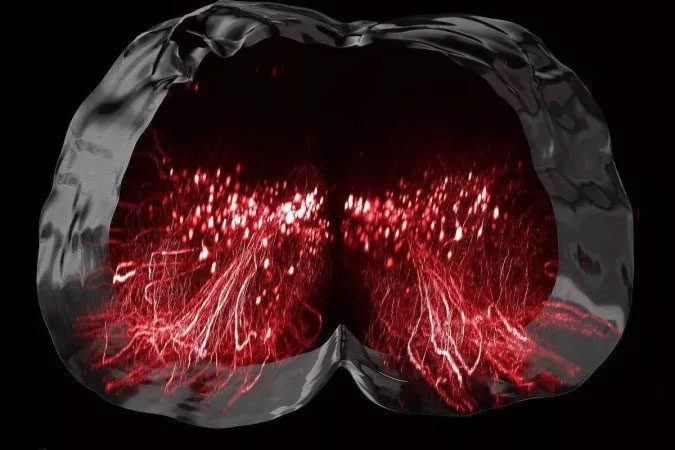The Swiss research group NeuroRestore has assisted 9 patients with paralysis in regaining the function of their legs through a method that combines electrical stimulation and high-intensity physical therapy.
According to Science Alert, the volunteers participating in the trial were all severely or completely paralyzed due to spinal cord injuries. Remarkably, all of them showed immediate improvement and continued to get better over the next 5 months using this unique new method.
This achievement is the result of the Swiss research team NeuroRestore, led by neuroscientist Claudia Kathe from the École Polytechnique Fédérale de Lausanne (EPFL). The groundbreaking work has just been published in the scientific journal Nature.

Graphic showing stimulated neurons – (Image: NEURORESTORE)
To begin, they accurately identified the specific nerve groups that needed stimulation and tested them on mice.
These are the neurons that coordinate walking, found in the spinal cord running through our lower back. Spinal cord injuries can disrupt the signal chain from the brain, preventing us from walking even when these specific lumbar neurons remain intact. They are still there, effectively not losing the ability to control walking, simply “losing the signal.”
Some previous studies have demonstrated that spinal cord electrical stimulation can reverse such paralysis, but how this occurs is not clearly understood.
Therefore, the Swiss research team experimented with a technology called epidural electrical stimulation in both mouse trials and subsequent clinical trials on the aforementioned 9 patients.
The spinal cord was stimulated by a neurotransmitter delivered through surgery. The patients also underwent an intensive neurorehabilitation process, supported by robotics.
After just 5 months of intervention 4-5 times a week using this method, all volunteers were able to walk with the aid of a walker.
To the researchers’ surprise, the recovered patients actually showed changes in neuronal activity in the lumbar spinal cord while walking. The research team believes this is due to the refined activity of a specific subset of neurons necessary for walking.
To explain this, the research team modeled the process in mice and used a combination of RNA sequencing and spatial transcriptomics—a technique that allows scientists to measure and map gene activity in specific tissues—to understand what the cells are doing.
They identified a previously unknown population of neurons that can take over the tasks of affected cells after an injury, found in the intermediary layer of the lumbar spinal cord.
This tissue, composed of cells named SCVsx2:Hoxa10 neurons, appears unnecessary for walking in healthy animals but serves as a “reserve” when the ones currently in use are damaged.
This is just one component of a very complex chain of cells that receive and send information, so there is still much to study. However, this is enough to affirm that the human body still harbors the potential for self-compensation and recovery; we just need to find a way to unlock that treasure.
Da Hong Pao – The Rare National Tea Treasure of China, priced up to 30 billion VND/kg


















































